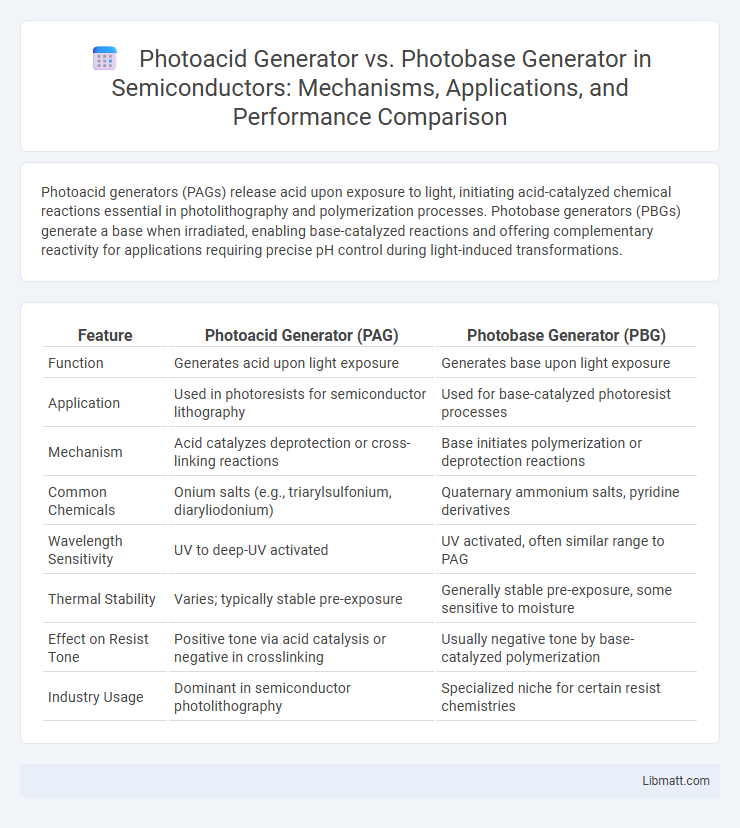Photoacid generators (PAGs) release acid upon exposure to light, initiating acid-catalyzed chemical reactions essential in photolithography and polymerization processes. Photobase generators (PBGs) generate a base when irradiated, enabling base-catalyzed reactions and offering complementary reactivity for applications requiring precise pH control during light-induced transformations.
Table of Comparison
| Feature | Photoacid Generator (PAG) | Photobase Generator (PBG) |
|---|---|---|
| Function | Generates acid upon light exposure | Generates base upon light exposure |
| Application | Used in photoresists for semiconductor lithography | Used for base-catalyzed photoresist processes |
| Mechanism | Acid catalyzes deprotection or cross-linking reactions | Base initiates polymerization or deprotection reactions |
| Common Chemicals | Onium salts (e.g., triarylsulfonium, diaryliodonium) | Quaternary ammonium salts, pyridine derivatives |
| Wavelength Sensitivity | UV to deep-UV activated | UV activated, often similar range to PAG |
| Thermal Stability | Varies; typically stable pre-exposure | Generally stable pre-exposure, some sensitive to moisture |
| Effect on Resist Tone | Positive tone via acid catalysis or negative in crosslinking | Usually negative tone by base-catalyzed polymerization |
| Industry Usage | Dominant in semiconductor photolithography | Specialized niche for certain resist chemistries |
Introduction to Photoacid and Photobase Generators
Photoacid generators (PAGs) release strong acids upon exposure to light, initiating acid-catalyzed chemical processes primarily used in photolithography and polymer chemistry. Photobase generators (PBGs) similarly release strong bases when irradiated, triggering base-catalyzed reactions essential for applications like photoresist development and surface modification. Both PAGs and PBGs serve as critical photoinitiators, controlling reaction pathways through light-induced generation of acidic or basic species.
Fundamental Principles of Photoacid Generators
Photoacid generators (PAGs) operate by releasing strong acids upon exposure to light, initiating acid-catalyzed reactions critical in photolithography and polymerization processes. These compounds undergo photolysis to produce protonic acids, which decrease the local pH and trigger chemical changes essential for patterning or curing materials. Understanding the fundamental photochemical mechanisms of PAGs enables precise control over reaction kinetics and spatial resolution in microfabrication technologies.
Fundamental Principles of Photobase Generators
Photobase generators (PBGs) release a basic species upon exposure to light, triggering deprotonation reactions that initiate polymerization or cross-linking in photoresist materials. Unlike photoacid generators (PAGs), which produce protons to catalyze acid-driven processes, PBGs typically generate amines or other nitrogenous bases through photolysis. The fundamental principle of PBGs revolves around the photochemical cleavage of a precursor molecule, resulting in a strong base that alters the chemical environment and facilitates base-catalyzed reactions critical for negative-tone resist patterning.
Key Differences Between Photoacid and Photobase Generators
Photoacid generators (PAGs) release protons upon exposure to light, inducing acid-catalyzed reactions, whereas photobase generators (PBGs) release a base to initiate base-catalyzed processes. PAGs are commonly used in acid-catalyzed polymerizations and photolithography, while PBGs are employed in applications requiring deprotonation or neutralization mechanisms. The fundamental distinction lies in their photochemical behavior and the chemical environment they create, influencing reaction pathways and product outcomes.
Mechanisms of Action: How PAGs and PBGs Work
Photoacid Generators (PAGs) release protons upon exposure to UV or electron beam radiation, initiating acid-catalyzed reactions such as photoresist polymerization or deprotection in photolithography. Photobase Generators (PBGs), in contrast, produce basic species like amines when irradiated, triggering base-catalyzed reactions that can neutralize acids or initiate polymerization via deprotonation. Understanding these mechanisms helps you select the appropriate photoactive compound for precise control over reaction pathways and material properties in microfabrication and photochemical processes.
Applications of Photoacid Generators in Industry
Photoacid generators (PAGs) are extensively used in semiconductor lithography to enable precise patterning of photoresists during chip fabrication. Their ability to release strong acids upon UV exposure facilitates chemical amplification, enhancing resolution in microelectronics manufacturing. PAGs also find applications in polymer cross-linking and photo-patterning processes in the production of advanced optical materials and coatings.
Applications of Photobase Generators in Industry
Photobase generators (PBGs) play a crucial role in industries such as electronics, coatings, and adhesives by initiating polymerization and curing processes under UV light. Their application enhances the efficiency of photoresists and improves the performance of light-sensitive materials in semiconductor manufacturing and 3D printing. Your use of PBGs ensures precise control over chemical reactions, leading to higher-quality products and faster production cycles.
Advantages and Limitations of PAGs and PBGs
Photoacid generators (PAGs) offer precise acid production upon light exposure, enabling high-resolution lithography with excellent pattern fidelity, but their sensitivity to moisture and limited stability can hinder long-term applications. Photobase generators (PBGs) provide controlled base release that enhances polymerization processes and reduces acid-catalyzed degradation, although they may require longer irradiation times and exhibit lower quantum efficiency compared to PAGs. Understanding the specific advantages and limitations of your chosen generator type is crucial for optimizing photochemical reactions in advanced materials and microfabrication.
Recent Advances in PAG and PBG Technology
Recent advances in Photoacid Generator (PAG) and Photobase Generator (PBG) technologies have led to enhanced sensitivity and resolution in photolithography applications. Innovations in molecular design have improved the quantum efficiency and thermal stability of PAGs and PBGs, enabling precise control over acid or base generation upon light exposure. Cutting-edge research emphasizes the development of dual-functional PAG/PBG systems, promoting versatile photoresist performance for next-generation semiconductor fabrication processes.
Future Trends and Innovations in Photogenerated Chemistry
Photoacid Generators (PAGs) and Photobase Generators (PBGs) are evolving with innovations in photogenerated chemistry, emphasizing enhanced quantum efficiency and wavelength selectivity for next-generation photolithography and 3D printing. Advances in organic and inorganic molecular design are driving improved stability and tunability, enabling precise control over acid-base generation triggered by light exposure. Future trends suggest integration with nanomaterials and upconversion nanoparticles to achieve deeper penetration depths and spatial resolution in photoinduced reactions essential for microelectronics and biomedical applications.
Photoacid Generator vs Photobase Generator Infographic

 libmatt.com
libmatt.com